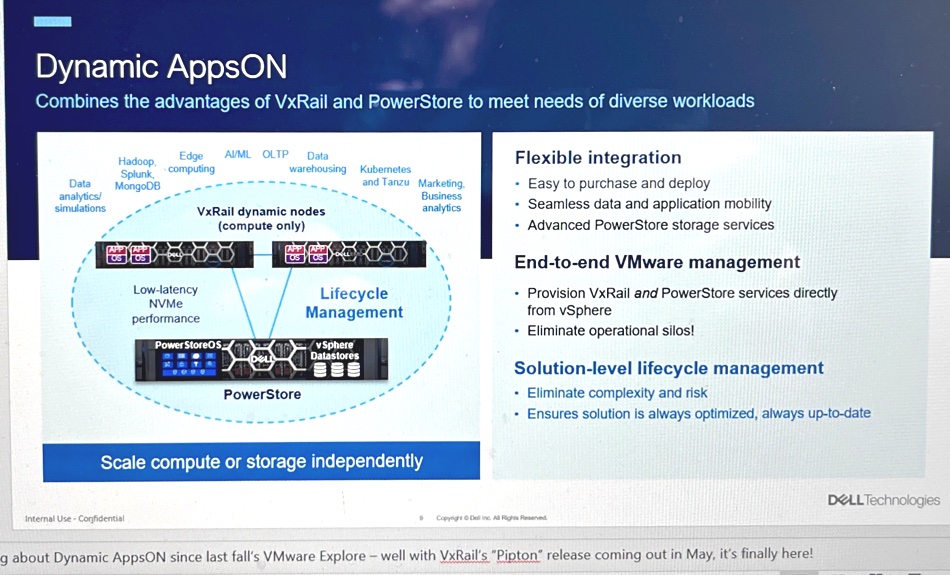Dell is giving its all-flash PowerStore array direct integration with PowerProtect backup appliances, enabling it to provide storage nodes to VxRail hyperconverged infrastructure compute nodes for separate compute and storage scaling, and be more secure and effective.
PowerStore, Dell’s mid-range unified file and block storage array, is receiving a raft of software updates around security, protection, DevOps and hyperconverged infrastructure (HCI) integration. The relentless Dell software development machine has delivered, it says, more than 2,000 storage portfolio advancements in the past 12 months.
Jeff Boudreau, president and GM of Dell’s Infrastructure Solutions Group, said: “We’re helping customers rise to this challenge by enabling them to make the most of their IT investments with storage software innovation that is more energy efficient, boosts productivity and strengthens cyber resiliency.” Do more with less, as it were.
The watchwords are productivity and protection, both in the data backup and anti-malware senses.
Security and data protection
PowerStore is getting:
- STIG hardening – Security Technical Implementation Guides (STIGs) are US federal government and Department of Defense configuration standards and this adds to PowerStore’s compliance with the NIST Cyber Security Framework standard, required for US federal networks and other government entities worldwide.
- Secure and immutable snapshots to prevent unauthorized deleting or modifying of snapshots before their expiration date.
- Streamlined file permissions so storage admins can manage access directly from PowerStore in security threat scenarios.
- Up to 4x more mounted snapshots per system, meaning more protection points for granular recovery.
- Multi-factor authentication.
- Native integration with PowerProtect and its 65:1 data reduction.
Backups can be configured in less than two minutes, directly from the PowerStore user interface. It works with physical and virtual PowerProtect appliances and can backup to the cloud.
Drew Schulke, Dell VP for product management, said: “The key thing is the ease of use, being able to do it from within the UI, ditching the need for a dedicated backup server, getting the network traffic down.”
Ben Jastrab, Director for Storage Product Marketing, added: “The really beautiful thing about the whole integration is that you can orchestrate and manage the backups and restores directly from PowerStore manager. So you don’t have to go into a separate console, you’re not using a backup system. The storage administrator is able to see what you’re backing up and when, and set the policies. They can do it in 90 seconds or less.”
Productivity
There are DevOps workflow enhancements such as integrations with Ansible and Terraform. The Ansible support, Jastrab said, “includes some additional VMware support around vVols, VMFS and vCenter.”
Dell Container Storage Modules are open source storage array enablers for containers accessed in Kubernetes environments through CSI plug-ins. These are now supported by PowerStore.
Jastrab told us: “This is enabling actual cloning of stateful applications that are container-based and allows you to move them from one cluster to another.”

PowerStore is also now able to provide storage nodes to VxRail dynamic (compute-only) hyperconverged infrastructure nodes with the Dynamic AppsON feature, enabling separate scaling of compute and storage. This is pretty much the same functionality as that just announced by Nutanix.
The latest PowerStore arrays are Energy Star-certified. Jastrab told us: “We’ve got a few models that are already certified, and there’ll be more that will be coming down the road.”
And there’s more
This update blast from Dell also includes:
- PowerMax enables an operational airgap for faster recovery of compromised data following a cyberattack.
- PowerFlex gets enhanced NVMe/TCP and security.
- ObjectScale has faster enterprise S3 object storage performance and simpler deployment and support experience.
- CloudIQ, Dell’s AIOps software, is improved and extends its VMware integration.
- Unity XT has increased Ansible support for storage automation.
Overall this latest set of announcements tells Dell’s customers that it’s committed to developing its products and makes competing with Dell more difficult for smaller suppliers.
Availability
PowerMax, CloudIQ and Unity XT capabilities are globally available today. PowerStore and ObjectScale advancements will be globally available in June 2023, and PowerFlex advancements will be globally available in the third 2023 quarter.








